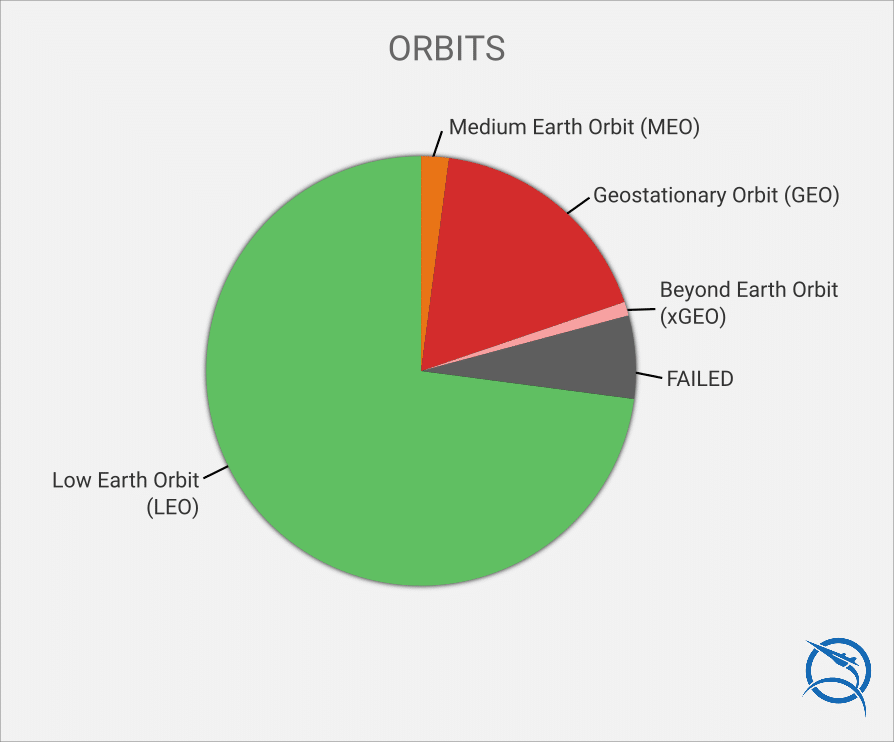On the Rise
The first half of 2023 saw 97 global orbital launch attempts, surpassing the 75 launch attempts carried out in the first half of 2022. If this pace is maintained, total 2023 launches will just barely surpass 2022 (194 vs 186). However, if 2023 matches 2022’s second half % growth, it will be on track for a total of 241 launches. And this doesn’t even include suborbital flights like Rocket Lab’s HASTE or Virgin Galactic’s return to flight. So, let’s jump into things!
Launches from Around the World
Breaking this out at the country level, most of the launches are being driven by the United States & China. The U.S. hosted 49 launches with 4 additional launches by U.S. companies being carried out elsewhere (Rocket Lab had 3 launches from New Zealand and Virgin Orbit conducted their final launch from Spaceport Cornwall out of the United Kingdom).

China performed 25 launches followed by Russia with 9 launches from their spaceports in Russia and Kazakhstan. India is starting to pick up the pace with 4 launches in 2023 so far and is expected to improve its cadence going forward. Japan and South Korea are also ramping up their sovereign launch capabilities and should have a larger launch presence in the years to come. Speaking of sovereign launch capability, Europe has entered the period when it is without an active sovereign launch vehicle after the final Ariane 5 launch last week. The previous Ariane 5 launch was the sole launch in the first half of 2023 to utilize the spaceport out of French Guiana. Finally, Israel and North Korea each performed a single launch attempt. Both launched military spy satellites but only Israel’s made it to orbit. Speaking of which…
Where’s Everyone Going?
Over 75% of launches were put into Low Earth Orbit (LEO) where many companies and agencies are deploying constellations like SpaceX’s Starlink (>4,000 Starlink satellites now in orbit). Israel’s launch is interesting because they put their satellite into a LEO-Retrograde orbit. Israel launches west to make sure any debris falls into the Mediterranean Sea rather than on people (good call), so their launches fight Earth’s rotation. Because of this, their satellites usually deorbit on the order of months rather than years.

The next most popular orbit with almost 20% of the launches is geostationary orbit (GEO) where the satellites are typically larger and can cover much more of the Earth. As a note, we are including launches that put payloads into geostationary transfer orbits (GTO) as GEO launches. We decided to focus on the final intended orbit rather than the initial drop-off. Medium Earth Orbit (MEO) got 2% of successful launches. This orbital regime is somewhat underutilized but appears to be gaining some traction for future constellations.
Finally, there was one launch that’s leaving Earth’s orbits behind. ESA’s JUICE spacecraft (~37 seconds into the animation) is on course for Jupiter and its moons after flying on Ariane 5’s penultimate launch. Missions beyond Earth’s orbits are still relatively rare but looking ahead to the next half of 2023, there should be a few more trips to Earth’s moon to look forward to.
SpaceX Continues to Dominate
Of the 49 U.S. launches, 44 were performed by SpaceX (~90%). Half of SpaceX’s launches were primarily for Starlink satellites though. The other half serviced customer payloads including 3 Transporter rideshare missions and 4 ISS missions. Included here was also SpaceX’s first flight attempt of the fully stacked Starship/Super Heavy launch vehicle …which ended with a bang (~39 seconds into the animation). Right now, no other launch company is close to SpaceX’s cadence but that could change over the next few years with numerous new launchers coming online. In the meantime, SpaceX will be driving majority of the launches again in the second half of 2023.
The ISS has a New Neighbor
There were 9 trips to space stations in the first half of 2023. Russia had 2 cargo resupply missions with their Progress modules and 1 uncrewed Soyuz mission to replace the previous Soyuz crew capsule that had a coolant leak. SpaceX carried out 2 cargo resupply missions, 1 crewed mission for NASA, and 1 private crewed mission for Axiom. The 6 U.S. and Russian missions were all to the International Space Station (ISS), but China performed 1 cargo and 1 crewed mission to their new Tiangong Space Station (TSS). As we move later into the decade, commercial space stations will start to become available and have their own cargo & crew transportation needs.
Can’t Make an Omelet Without Breaking a Few Eggs…
Unfortunately, not every launch was able to reach their desired orbit. There were 6 failed launch attempts so far this year. 4 were first launch attempts by ABL’s RS-1, Mitsubishi Heavy Industries’ H3, Relativity’s Terran 1, and SpaceX’s Starship/Super Heavy. A couple of these companies may have considered their attempts “successful” depending on where they set the bar for success (hint: it wasn’t reaching orbit). North Korea failed to launch their first spy satellite which has been heavily criticized by North Korean leadership, but they are planning a second attempt soon. Finally, Virgin Orbit’s failed launched from the U.K. (8 seconds into the animation) was probably the most detrimental of the failed launch attempts. This was not a first attempt and it was carrying customer payloads. The failure eventually led the way to Virgin Orbit’s bankruptcy and dissolution earlier this year.
We’re Just Getting Started
With another 6 months ahead of us, we’ll see more first attempts, improved second attempts, and even more successful launches to space. SpaceX will continue to dominate the overall launch numbers while other launch providers will start to pick up their cadences. Keep an eye out for a few missions to the moon too. Check back with us at the end of the year to see all the exciting launches from around the world!

